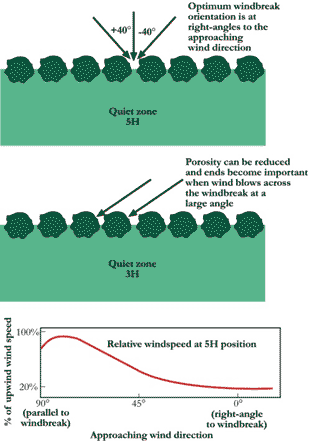|
Orientation of Shelterbelts
Although wind direction changes, farmers commonly identify
particularly damaging winds as coming from a certain direction.
It might be the strong southwest winds associated with rain
following a frontal system that is of greatest concern during
lambing in southern Australia. For a cropping farmer it might
be the drying northerlies that are the main concern.
The best orientation for a shelterbelt is 90o to the damaging
winds. However, shelterbelts are still quite effective up
to 40o in either direction, allowing farmers to design belts
according to the location of fences and landforms. As winds
travel around contours, in hilly country, belts should run
up and down slopes.

Reference: Cleugh, H. (1997), 'Trees for Shade and Shelter'
in Design Principles for Farm Forestry: A guide to assist
farmers to decide where to plant trees and farm plantations
on farms eds. Abel, N. et al, RIRDC, Canberra, pp.39-52
.gif)
Reference: Burke, S. (1998), Windbreaks, Inkata Press, Port
Melbourne
For winds parallel to a windbreak, wind speed reductions still
occur to approximately 4H of the belt due to the effect of
momentum absorption of the tree crowns and drag effects on
wind flow.
The most effective shelterbelts are those that are linked
together forming a network. This arrangement reduces the extent
to which the wind is able to wrap around the ends of the shelterbelts.
Back to top
|
